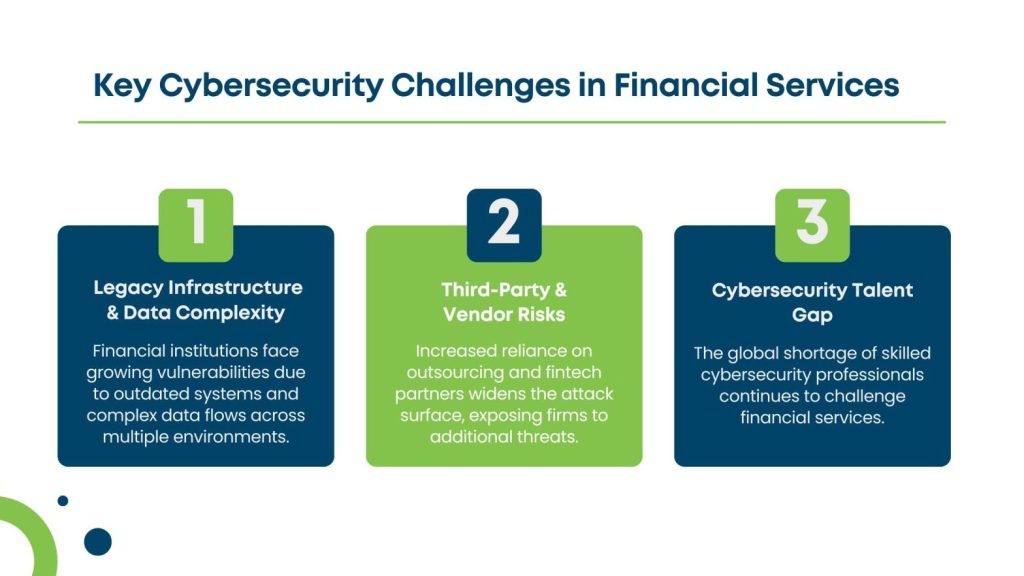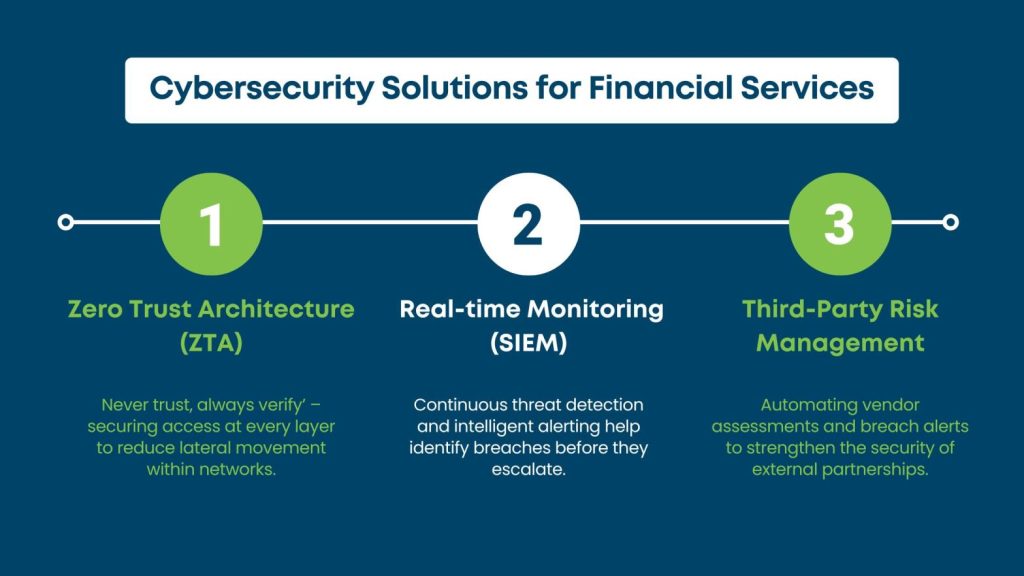- May 13, 2025
- by NCS Global
- 6mins read
The financial industry has always been a magnet for cybercriminals, but in 2025, the stakes have risen dramatically. As more financial institutions go digital and embrace new technologies, the opportunities for malicious actors to exploit vulnerabilities have grown in parallel. In this climate, Financial Services Cybersecurity has become a top boardroom priority, not just an IT concern.
From digital banking to fintech ecosystems and open finance platforms, the industry is operating in an increasingly interconnected environment. While these advances create efficiency and convenience, they also expose financial firms to evolving and more complex risks. Let’s unpack the key cybersecurity challenges plaguing the industry today and the strategies being used to combat them.
The Expanding Threat Landscape in 2025
The nature of cybersecurity threats in financial services has transformed significantly over the past few years. Cybercriminals are no longer just targeting large banks with brute-force attacks. Today, threat actors are more organised, funded, and sophisticated, using tactics like social engineering, deepfakes, ransomware-as-a-service (RaaS), and API manipulation to breach systems.
One of the most alarming developments is the surge in supply chain attacks. Financial institutions are often deeply integrated with third-party vendors, cloud service providers, and fintech partners. A single breach in any part of this chain can have cascading consequences across the entire network. The problem is compounded by the increasing use of open APIs in digital banking, which, while enabling innovation, also widen the attack surface.
Remote work and hybrid models have introduced additional risks. With employees accessing systems from home or public networks, the potential for insider threats, both accidental and malicious, is higher than ever.

Major Cybersecurity Challenges Facing Financial Institutions
Modern financial firms face a unique blend of legacy limitations and forward-facing challenges:
- Legacy Infrastructure:
Many financial organisations still rely on outdated systems that aren’t built to withstand modern threats. Patching these systems is often complex and slow, creating windows of vulnerability. - Data Complexity:
With operations spanning cloud, on-premises, and hybrid environments, maintaining data protection in financial services industry is an intricate task. Sensitive customer data flows through multiple channels, each requiring robust protection. - Vendor and Third-Party Risk:
Fintech collaborations, outsourcing, and cloud adoption have significantly increased exposure to external threats. With the rise of outsourced accounting and external compliance partnerships, financial institutions must assess the cybersecurity posture of every third-party service provider they engage with. - Regulatory Pressure:
Keeping up with evolving financial services cybersecurity regulations adds another layer of complexity. Regulatory frameworks are tightening globally, demanding more from institutions in terms of documentation, response time, and security standards. - Cybersecurity Talent Gap:
The global shortage of cybersecurity professionals is acutely felt in financial services. The competition for skilled security personnel continues to intensify.
The Regulatory Landscape in 2025
Compliance has taken center stage in 2025. Regulatory bodies worldwide have enforced stricter and more comprehensive rules in response to escalating cyber threats.
In Australia, APRA’s CPS 230 standard is pushing financial entities to strengthen operational resilience, including cybersecurity. The U.S. Securities and Exchange Commission (SEC) now requires detailed cybersecurity disclosures and incident reporting. In Europe, updates to the GDPR, along with the Digital Operational Resilience Act (DORA), have added more weight to financial firms’ security responsibilities.
These evolving financial services cybersecurity regulations mean that businesses must be proactive, not reactive. The cost of non-compliance isn’t just regulatory fines, it includes reputational damage, customer attrition, and operational disruptions.
Cloud Cybersecurity and the Need for Vigilance
The migration to cloud-based platforms is nearly ubiquitous in financial services. While the benefits include scalability and cost-efficiency, it’s not without risk. Cloud cybersecurity in financial services now requires more than just perimeter defense. Financial institutions must adopt layered security models that include data encryption, robust access control, continuous monitoring, and incident response automation.
Misconfigured cloud environments remain one of the leading causes of data breaches. And as more institutions adopt multi-cloud strategies, ensuring consistent policies across environments becomes more challenging. A shared responsibility model, where both the cloud provider and the institution have defined security roles, is critical but often misunderstood. As firms adopt more agile models like on-demand accounting, ensuring real-time data protection becomes critical, especially when financial data is accessed through cloud platforms and remote devices.

Strategic Cybersecurity Solutions for Financial Services
In response to these multifaceted threats, institutions are embracing a mix of technological and procedural countermeasures. The emphasis is on resilience, not just defending against attacks, but also recovering swiftly when breaches occur.
Cybersecurity Solutions for Financial Services include:
- Zero Trust Architecture (ZTA):
This model operates on the principle of ‘never trust, always verify,’ minimising lateral movement within networks and securing access at every layer. - Security Information and Event Management (SIEM):
Real-time monitoring and intelligent alerting help organisations detect threats early and respond quickly. - Regular Penetration Testing and Risk Assessments:
These help institutions stay ahead by identifying vulnerabilities before malicious actors can exploit them. - Employee Awareness Programs:
Since human error remains a major contributor to breaches, regular training on phishing, password hygiene, and data handling is crucial. - Multi-Factor Authentication (MFA) and Biometric Verification:
Enhancing identity management with secure login practices. - Third-Party Risk Management Platforms:
Automating vendor assessments, compliance tracking, and breach alerts. - Disaster Recovery and Incident Response Planning:
Clear protocols that enable quick action when systems are compromised, minimising downtime and data loss.
Outsourcing and Managed Cybersecurity Services
Given the resource constraints and complexity of modern cyber threats, many financial institutions are turning to Managed Security Service Providers (MSSPs). Outsourcing certain cybersecurity functions can provide access to advanced tools, 24/7 monitoring, and specialised expertise.
However, due diligence is key. Institutions must thoroughly vet providers to ensure alignment with regulatory requirements and internal risk thresholds. A poorly chosen partner can introduce more risk than they resolve.
Building a Cyber-Resilient Future
Ultimately, financial firms must approach security as a holistic, organisation-wide effort. The concept of resilience, the ability to adapt, endure, and recover from disruptions, is now central to every strategic conversation.
Cybersecurity isn’t just about building walls; it’s about creating systems that can continue to function under stress. That means:
- Embedding security into digital transformation initiatives.
- Making cybersecurity a board-level discussion.
- Collaborating across departments to manage risk.
- Integrating incident response with business continuity plans.
In 2025, Financial Services Cybersecurity is no longer a back-office concern. It’s a competitive differentiator and a core pillar of trust. Institutions that invest in resilience today will be better positioned to thrive in an increasingly complex digital landscape tomorrow.
Final Thoughts
The cybersecurity landscape for financial services is dynamic and demanding. With new threats emerging and regulations evolving, institutions must prioritise agility, accountability, and awareness.
By adopting comprehensive cybersecurity solutions for financial services, addressing regulatory expectations, and reinforcing their cloud and data protection strategies, financial firms can reduce exposure, increase customer trust, and maintain operational integrity. The road ahead may be complex, but the tools and strategies to stay secure are already within reach.
In addition, many financial institutions are increasingly turning to financial services outsourcing to bolster their cybersecurity and operational resilience. Outsourcing non-core functions, such as IT support, compliance, and even accounting, allows firms to access specialised expertise and resources, enabling them to focus on their core competencies while strengthening their overall security posture.
Frequently Asked Questions (FAQs)
- What are the top cybersecurity threats facing financial institutions?
Cybersecurity threats in financial services today include ransomware attacks, phishing, insider risks, API manipulation, and third-party breaches, especially those tied to cloud adoption, fintech integration, and digital banking expansion.
- How are machine learning and automation impacting financial cybersecurity threats?
Machine learning has improved threat detection in real time, but it has also enabled more deceptive attacks. Financial firms now face adversaries who use the same tools to bypass detection systems, simulate user behavior, and scale malicious activity.
- What cybersecurity solutions are financial firms adopting?
Financial institutions are adopting Zero Trust architecture, biometric access, continuous monitoring, multi-factor authentication, penetration testing, and risk assessment tools to protect systems and reduce vulnerabilities in a dynamic threat landscape.
- How is the financial industry addressing third-party and supply chain cyber risks?
Institutions are tightening third-party onboarding protocols, conducting regular security audits, implementing automated vendor risk platforms, and maintaining transparency with fintech partners to minimise potential points of failure and data leaks.
- What role do government regulations play in financial cybersecurity strategies?
Regulations increasingly require incident disclosure, resilience frameworks, real-time reporting, and strict oversight. These rules shape how firms manage cybersecurity, from board-level risk strategy to vendor compliance and response preparedness.






